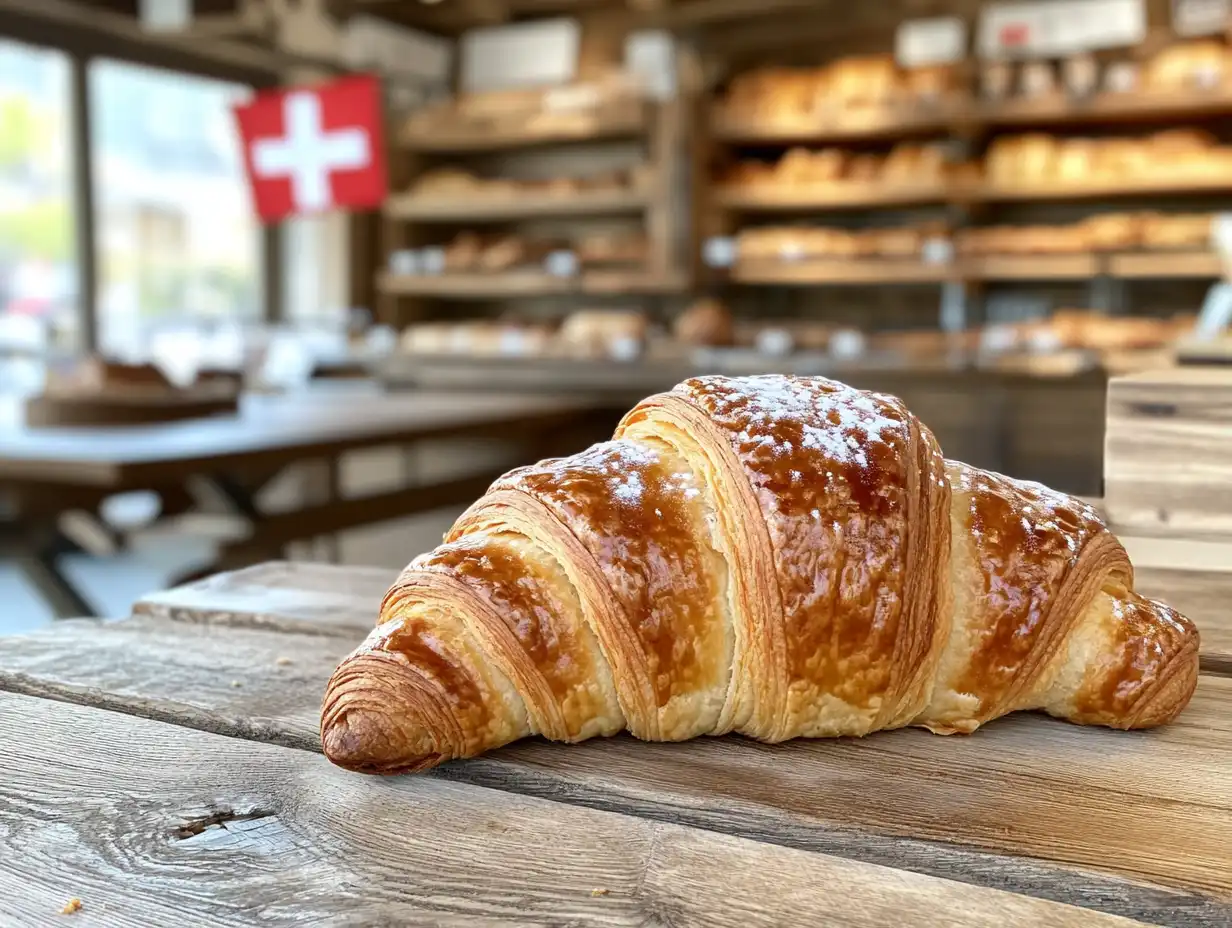Introduction
The croissant, known as “Gipfeli” in Switzerland, is a beloved pastry enjoyed for its buttery layers and crescent shape. If you’re wondering, what is a croissant called in Switzerland, the answer varies depending on the region, but “Gipfeli” is the most common name in German-speaking areas. This treat is an integral part of Swiss culture, reflecting the nation’s linguistic and culinary diversity.
Switzerland’s rich culinary traditions have seamlessly adopted and transformed the croissant. This article explores in depth what is a croissant called in Switzerland, the unique traits of the Swiss Gipfeli, its cultural significance, and the fascinating regional variations.
The Role of Croissants in Swiss Breakfast Culture
Croissants, or Gipfeli, play a prominent role in Swiss breakfast culture. Swiss breakfasts are often light, consisting of bread, butter, and jams, and the inclusion of a freshly baked Gipfeli elevates this simple meal. In Switzerland, breakfast isn’t just about sustenance—it’s also a cherished moment of relaxation, and pastries like Gipfeli fit perfectly into this tradition.
Even in hotels and cafés, what is a croissant called in Switzerland often depends on the region. Guests in German-speaking areas will see “Gipfeli” on menus, while in French-speaking areas, “croissant” is commonly used. Either way, the pastry’s role as a breakfast staple remains unchanged.
The Swiss Version of the Croissant
In Switzerland, croissants are most commonly referred to as “Gipfeli,” particularly in German-speaking regions. While the name may change depending on the local language, the essence of the pastry remains the same—a light, flaky, and buttery delight.
Variations in Language
Switzerland’s linguistic diversity influences the name of the croissant.
- German-speaking regions: Known as “Gipfeli,” derived from the German word “Gipfel,” meaning “peak” or “summit,” reflecting the crescent’s shape.
- French-speaking regions: Called “croissant,” the same as in France, due to shared language and culinary ties.
- Italian-speaking regions: Often referred to as “cornetto,” similar to the Italian terminology.
Swiss-German Name for Croissants
The term “Gipfeli” holds cultural and linguistic significance in German-speaking Switzerland. Unlike the French croissant, which emphasizes elegance, the Gipfeli reflects Swiss simplicity and practicality. It is a household name, evoking memories of cozy breakfasts and the aroma of freshly baked pastries.
Difference Between Gipfeli and Croissant
Although Gipfeli and croissants share similarities, they differ in certain aspects:
- Shape and texture: Gipfeli are often smaller and less buttery than traditional French croissants. They might have a slightly denser texture, making them ideal for filling with jams, butter, or cheese.
- Typical ingredients: While both are made from a laminated dough of flour, butter, and yeast, Gipfeli may include local variations like spelt flour or reduced butter content to cater to regional tastes.
Regional Preferences in Switzerland

Switzerland’s regional diversity extends to the fillings and variations of Gipfeli. Depending on the area, preferences can range from sweet to savory.
Savory vs. Sweet Fillings
- Nut-based fillings: Almond paste and hazelnut spreads are common choices for a sweet touch.
- Cheese and ham options: For those who prefer savory pastries, Gipfeli filled with Emmental cheese, ham, or spinach are popular.
This adaptability of Gipfeli makes it a versatile snack for any time of the day.
How Croissants Arrived in Switzerland

The croissant’s journey to Switzerland is a story of cultural exchange and adaptation. While the pastry is often associated with France, its origins trace back to Austria and the Kipferl, a crescent-shaped pastry that has existed since at least the 13th century.
Connection to Austrian Kipferl
The Kipferl, an ancestor of the modern croissant, was introduced to Western Europe during the 17th century. This crescent-shaped bread was simpler than today’s croissant, often denser and less buttery. It is believed that Austrian bakers brought the Kipferl to France, where it evolved into the flaky, layered croissant we know today.
Switzerland, situated between Austria and France, adopted and adapted this pastry, creating its own version in the form of Gipfeli. Over time, Gipfeli became a staple in Swiss bakeries, reflecting the influence of both Austrian and French culinary traditions.
Croissants in Modern Swiss Bakeries
Today, croissants and Gipfeli are ubiquitous in Swiss bakeries, from local artisanal shops to large chains like Coop and Migros. These bakeries cater to diverse tastes, offering traditional plain Gipfeli alongside innovative variations.
- Local bakeries: Many smaller bakeries maintain traditional recipes, ensuring a more authentic and handmade product.
- Popular chains: Chains like Sprüngli or Bachmann often experiment with fillings and toppings, creating modern twists on the classic Gipfeli.
The presence of croissants in Swiss bakeries highlights the balance between tradition and innovation in the country’s culinary landscape.
Homemade Croissants in Switzerland
For those who enjoy baking, homemade Gipfeli offers a rewarding experience. Many Swiss families adapt croissant recipes to include local ingredients or personal touches, such as spelt flour for a nuttier flavor or a touch of Swiss honey for added sweetness.
Home Baking Tips for Gipfeli
- Use cold butter: Ensuring the butter stays cold while laminating the dough creates the flaky layers that define a good Gipfeli.
- Experiment with fillings: Try traditional options like chocolate or jam, or opt for local ingredients like Swiss cheese or dried fruits.
- Patience is key: Laminated dough requires multiple rounds of rolling and folding, so allowing sufficient time for chilling is crucial for achieving the best results.
Nutritional Aspects of Swiss Croissants
Croissants and Gipfeli, while delicious, are considered indulgent treats due to their buttery and carbohydrate-rich nature. However, understanding their nutritional profile can help make informed choices.
Typical Caloric Content
A standard Gipfeli contains approximately 200–300 calories, depending on its size and filling. Savory versions with cheese or ham may have a higher calorie count due to the added fats and proteins.
Healthier Alternatives
- Whole-grain options: Some bakeries and home recipes incorporate whole-grain flours for added fiber and nutrients.
- Reduced-fat recipes: Using less butter or substituting with alternatives like margarine can slightly lower the fat content without compromising taste.
- Smaller portions: Opting for mini Gipfeli allows for portion control while still enjoying the treat.
How to Order Croissants in Switzerland
Ordering croissants or Gipfeli in Switzerland is straightforward, but understanding the local language and bakery etiquette can enhance the experience. Since Switzerland is multilingual, the name and method of ordering may vary by region.
Key Phrases to Use in German, French, and Italian
- German-speaking regions:
- “Ich hätte gern ein Gipfeli, bitte.” (I would like a croissant, please.)
- Pronounce “Gipfeli” with a soft “g” and emphasize the “-li” ending.
- French-speaking regions:
- “Je voudrais un croissant, s’il vous plaît.” (I would like a croissant, please.)
- Italian-speaking regions:
- “Vorrei un cornetto, per favore.” (I would like a croissant, please.)
Cultural Etiquette in Bakeries
- Politeness: Always greet the staff with a “Guten Morgen” (Good morning) or “Bonjour” before placing your order.
- Self-service vs. counter-service: In some bakeries, customers are expected to pick their own items using tongs, while others require placing an order at the counter.
- Payment: Cash is widely accepted, but most bakeries also accept credit or debit cards.
By following these simple tips, you can navigate Swiss bakeries with ease and enjoy your Gipfeli like a local.
Frequently Asked Questions (FAQs)
What is the origin of the name “Gipfeli”?
The name “Gipfeli” comes from the Swiss-German word “Gipfel,” meaning “peak” or “summit.” It refers to the crescent shape of the pastry, resembling a mountain peak.
Are croissants in Switzerland different from those in France?
Yes, Swiss croissants, or Gipfeli, are often less buttery and slightly denser compared to the classic French croissant. They also come in more variations, including both sweet and savory options.
What are some popular fillings for Gipfeli?
Gipfeli can be filled with a variety of ingredients, including sweet options like chocolate, jam, or almond paste, and savory fillings such as ham, cheese, or spinach.
Where can I find the best croissants in Switzerland?
The best croissants can often be found in small artisanal bakeries that prioritize traditional methods and high-quality ingredients. Chains like Sprüngli and Bachmann also offer excellent options.
Is there a vegan version of the Swiss croissant?
Yes, many bakeries now offer vegan Gipfeli made with plant-based margarine instead of butter, catering to dietary preferences without compromising taste.
Why are Gipfeli considered unique in Switzerland?
Gipfeli are unique due to their regional adaptations, smaller size, and less buttery texture, making them a distinctive part of Swiss culinary culture.
Uncovering the Swiss Croissant and More
If you’re intrigued by the Swiss version of croissants, here are some related articles to explore:
- Gipfeli Recipe: The Perfect Guide to Swiss Croissants – A detailed guide to making Gipfeli, the Swiss equivalent of croissants, with tips for perfection.
- Potato Rolls: A Deliciously Soft and Versatile Bread Option – Discover another popular bread option for a Swiss-style breakfast spread.
- Vanilla Bean Paste: Everything You Need to Know – Learn how to incorporate vanilla into pastries like Gipfeli for a unique flavor twist.
Dive into these articles to expand your knowledge of Swiss baked goods and their delightful variations!
Conclusion
Croissants, known as Gipfeli in German-speaking Switzerland, are a delightful representation of the country’s culinary diversity. While rooted in the traditions of France and Austria, Switzerland has made the pastry its own by adapting it to local tastes and ingredients. Whether enjoyed at a bakery or made at home, these crescent-shaped treats hold a special place in Swiss culture.
Exploring the variations in name, flavor, and preparation methods across Switzerland reveals the croissant’s universal appeal and local charm. Next time you visit Switzerland, don’t miss the opportunity to savor a freshly baked Gipfeli and experience this beloved treat for yourself.
